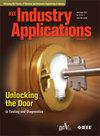一种构建同步电机等效电路模型的电机-驱动联合仿真方法
IF 4.2
2区 工程技术
Q2 ENGINEERING, ELECTRICAL & ELECTRONIC
引用次数: 0
摘要
本文介绍了一种建立各种同步电机模型的方法,称为等效电路模型(ECM)。开发 ECM 的目的是提出一种高效的机器模型,该模型可用于电机驱动联合模拟。其特点包括:(1) 计算速度快,适用于带有电压源变频器和控制器的电机-驱动器协同仿真;(2) 能够仿真饱和与谐波等电磁非线性特性;(3) 与标准电气元件的接口相同,可直接在电路仿真工具中实现;(4) 结构通用化,使大多数应用都能利用所提出的方法。拟议的 ECM 由三部分组成:(1) 表示物理的数学模型;(2) 来自有限元分析 (FEA) 结果、实验或其他可靠数据库的预处理磁通量关联数据库;(3) 在仿真软件中将数学模型与电路模型连接起来的等效电路元件。研究了同步电机,包括三相同步电机 (3jSM)、开口绕组同步电机 (OEWSM)、电励磁同步电机 (EESM) 和双三相同步电机 (D3jSM),以验证建议方法的功能。在这些案例中,使用了有限元分析模型作为参考。结果表明,在所研究的案例中,执行 ECM 的计算时间明显短于 FEA,而相对误差是可以接受的。最后,演示了基于 ECM 的电机驱动器协同仿真,并与各种运行条件下的实际电机驱动器系统进行了比较。本文章由计算机程序翻译,如有差异,请以英文原文为准。
A Method for Constructing Synchronous Electrical Machine Equivalent Circuit Models for Motor-Drive Co-Simulation
The paper introduces a method to model various synchronous electrical machines called the equivalent circuit model (ECM). The purpose of developing ECM is to present an efficient machine model that is feasible for motor-drive co-simulation. The features include (1) rapid computation for motor-drive co-simulation with voltage source inverters and controllers, (2) capability of simulating electromagnetic nonlinearities such as saturation and harmonics, (3) identical interface as a standard electrical component that can be implemented in circuit simulation tools directly, and (4) generalized construction to let most applications can utilize the proposed method. The proposed ECM consists of three parts: (1) mathematical model to represent the physics, (2) pre-processed flux linkage database from finite element analysis (FEA) results, experiments, or other reliable databases, and (3) equivalent circuit components that link the mathematical model to the circuit model in simulation software. Synchronous electrical machines, including a three-phase synchronous machine (3ϕSM), open-end-winding synchronous machine (OEWSM), electric-excited synchronous machine (EESM), and dual-three-phase synchronous machine (D3ϕSM), were investigated to validate the functionality of the proposed method. In these cases, FEA models were used as a reference. According to the results, the computation time of performing ECM was significantly shorter than that of FEA, while the relative error was acceptable in the studied cases. Finally, the ECM-based motor-drive co-simulation was demonstrated and compared with an actual motor-drive system under various operating conditions.
求助全文
通过发布文献求助,成功后即可免费获取论文全文。
去求助
来源期刊

IEEE Transactions on Industry Applications
工程技术-工程:电子与电气
CiteScore
9.90
自引率
9.10%
发文量
747
审稿时长
3.3 months
期刊介绍:
The scope of the IEEE Transactions on Industry Applications includes all scope items of the IEEE Industry Applications Society, that is, the advancement of the theory and practice of electrical and electronic engineering in the development, design, manufacture, and application of electrical systems, apparatus, devices, and controls to the processes and equipment of industry and commerce; the promotion of safe, reliable, and economic installations; industry leadership in energy conservation and environmental, health, and safety issues; the creation of voluntary engineering standards and recommended practices; and the professional development of its membership.
 求助内容:
求助内容: 应助结果提醒方式:
应助结果提醒方式:


